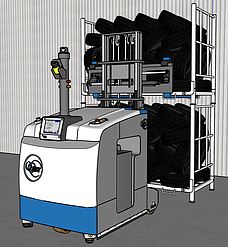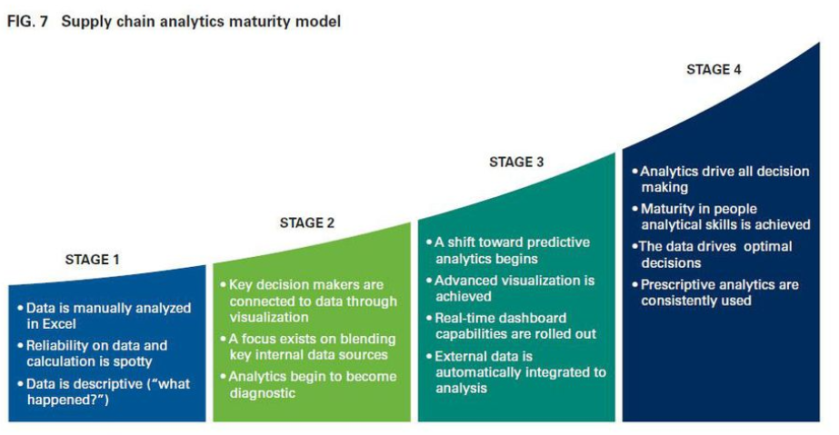JBT ist seit 35 Jahren ein Hersteller von fahrerlosen Transportsystemen. In dieser Zeit wurden über 5.000 Fahrzeuge weltweit erfolgreich ausgeliefert.
JBT hat sich auf anspruchsvolle FTS bzw. AGV Anwendungen spezialisiert, wie das Stapeln komplexer Gebinde, verwalten ganzer Block-Lager, beladen von LKW und die Handhabung von schweren Ladungsträgern größer >1,5 Tonnen.
JBT’s besitzt eine große Softwarekompetenz mit einem eigenen, ausgereiften Flottenmanager und In-House Software-Schnittstellen Kompetenz.
Die JBT Fahrzeuge werden komplett eigenständig entwickelt, produziert und Inbetrieb genommen.
JBT Automated Systems ist Teil der JBT Cooperation mit Hauptsitz in Chicago USA. Die FTS/AGV Produktion erfolgt in Kingston (New York) und Leicester UK.

Ein JBT Gegengewichtsstapler beim automatischen Stapeln eines Gestells in der Reifenindustrie.
JBT FTS/AGV helfen Ihnen bei:
Lager- und Lagerbewegungskosten senken:
Der Einsatz von JBT FTS/AGV Systemen ermöglicht die dauerhafte Reduktion der Kosten eines Gabelstaplers auf 5 EURO/Std.
Lieferbeschaffenheit- und qualität erhöhen:
Der Einsatz von JBT FTS/AGV Systemen reduziert Schäden am Ladegut deutlich und erhöht obendrein die Sicherheit Ihrer Mitarbeiter.
Sendungsanzahl erhöhen:
Automatisierte Staplersysteme operieren rund um die Uhr. Das Einführen einer 3. oder 4. Schicht, sogar als Geisterschicht, ist somit sehr einfach und schnell umzusetzen.
Peaks im Lager bewältigen:
JBT FTS/AGV Systeme können Aufträge auch Wochenenden und Feiertagen ausführen und manuelle Prozesse vorbereiten und somit PEAK Belastungen abmildern.
Facharbeitermangel begegnen:
Viele Prozesse lassen sich ökonomisch sinnvoll automatisieren. Mitarbeiter können sich auf die Verbesserung von Prozessen und Sonderaufgaben konzentrieren.
Sofortigen Return on Investment realisierbar:
Mit Hilfe individueller Finanzdienstleistungen können bestehende Logistikkosten sofort und ohne vorab Investment durch niedrigere Kosten ersetzt werden.
JBT Lösungsangebot
Staplen in Puffer- und Blocklagern
Ganze Blocklager oder Pufferlager vor oder nach Produktionsprozessen: Die JBT Stapel-Technologie ermöglicht platzsparende, vollautomatische Materialtransport- und Lagerprozesse in Ihrer Produktion oder Logistik.
JBT beherrscht das Stapeln von Gebinden 2,3,4 oder 5-Fach übereinander. Ganze Blocklager können somit rund um die Uhr verwaltet werden. Mit Hilfe der JBT Inventurfunktion des Standard Flottenmanagers kann die Lagerplatzwahl intelligent getroffen werden. JBT bietet somit eine komplette Lösung an.

Automatisches Beladen von LKW
JBT hat über 200 Fahrzeuge für das automatische Beladen von LKW ausgeliefert. Die speziell für diesen Zweck gebauten Fahrzeuge fahren wie gewöhnliche Stapler von hinten in den LKW ein und transportieren hierbei häufig zwei oder drei Ladungsträger gleichzeitig.
Hauptanwendungsfeld ist die Lebensmittel- und Getränkeindustrie. In allen Industrien in denen stetig produziert und verladen wird und die Produkte auf standardisierten Ladungsträgern transportiert werden, bieten sich ein Einsatz an.
Schwere und sperrige Ladegüter
JBT ist ein Spezialist für sperrige und schwere Ladungsträger. Ein häufiges Einsatzfeld hierfür ist der Transport von Baumaterialien wie Fertigbetonteile oder Gipskartonplatten in der Produktion. Die Fahrzeuge können bis 5 to transportieren und stapeln.
Ein weiteres Anwendungfeld für unsere “großen” Fahrzeuge ist der Transport von mehreren Standard-Ladungsträgern wie Euro-Paletten gleichzeitig. Hierdurch wie die Anzahl der Transporte und damit die Anzahl der Fahrzeuge reduziert und der Business Case und die Sicherheit verbessert.
JBT Stapeltechnologie
Wann macht ein Einsatz von FTS Systemen zum Stapeln von Gebinden Sinn:
Ihre Ladungsträger und Böden besitzen eine gute Qualität, sind also nicht sehr häufig stark beschädigt.
Mindestens zwei, idealerweise drei-Schichten Produktion um einen guten Business Case zu erreichen.
Der Bereich indem gestapelt wird, ist von Personenverkehr weitestgehend befreit oder Zäune können montiert werden.
Automatische LKW Beladung

Wann macht es Sinn über das automatische beladen von LKW nachzudenken:
Sie können mind. zwei Schichten am Tag verladen oder den Prozess in diese Richtung abändern.
Sonderprozesse, wie das anbringen von Ladungssicherheit, können weiterhin manuell durchgeführt werden.
Ihre Beladungsschema können standardisiert werden
Ihre Ladegut wird aktuell mit Gabelstaplern nicht mit Hochhubwagen eingelagert.
Transport und Stapeln von Gipskartonplatten
Wann macht ein Einsatz von FTS in der Bauindustrie Sinn:
Ihr Ladegut kann gestapelt werden.
Ihr Ladegut ist stabil transportierbar, Stretch-Folie ist kein Problem für JBT Fahrzeuge!
Der Transport und das Stapeln finden Innen statt.
Wir freuen uns auf Ihre Kontaktaufnahme
Thanks for submitting!
![]() +1 215-822-4600
+1 215-822-4600
![]() 400 Highpoint Dr, Chalfont, PA 18914, USA
400 Highpoint Dr, Chalfont, PA 18914, USA























